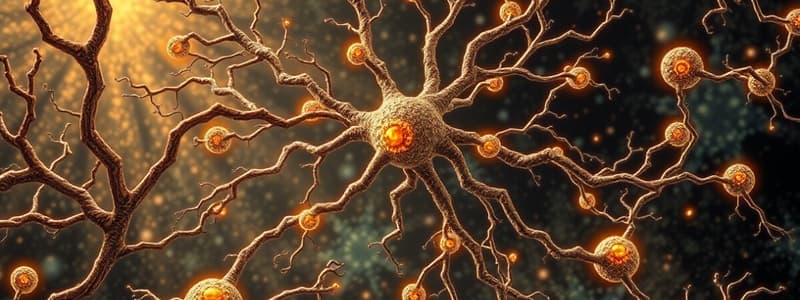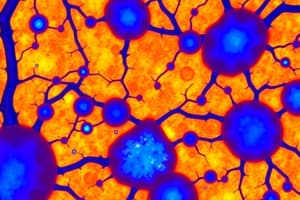Podcast
Questions and Answers
What was the primary innovation made by Camillo Golgi that advanced neuroscience research?
What was the primary innovation made by Camillo Golgi that advanced neuroscience research?
- Nerve-staining technique using silver nitrate (correct)
- Creation of reticular theory
- Introduction of magnetic resonance imaging
- Discovery of neurons
Which of the following best describes Santiago Ramón y Cajal's contribution to the neuron doctrine?
Which of the following best describes Santiago Ramón y Cajal's contribution to the neuron doctrine?
- He introduced the idea of life-long neuronal regeneration
- He provided evidence for discrete neurons connected via synapses (correct)
- He argued for the continuity of nerve fibers
- He proposed the existence of neuron clusters
Which specific technique did Cajal use to enhance the visualization of nerve cells?
Which specific technique did Cajal use to enhance the visualization of nerve cells?
- Computed tomography
- Fluorescent labeling
- Improved Golgi's silver nitrate method (correct)
- Magnetic resonance imaging
What does Cajal's illustration technique suggest about his approach to neuroscience?
What does Cajal's illustration technique suggest about his approach to neuroscience?
Which concept did Cajal and Golgi fundamentally disagree on despite their joint Nobel Prize?
Which concept did Cajal and Golgi fundamentally disagree on despite their joint Nobel Prize?
Who coined the term 'neuron' in 1891?
Who coined the term 'neuron' in 1891?
How did Cajal's findings challenge the prevailing reticular theory?
How did Cajal's findings challenge the prevailing reticular theory?
What was a misunderstanding about the reticular theory that Cajal addressed?
What was a misunderstanding about the reticular theory that Cajal addressed?
Why was Santiago Ramón y Cajal notably meticulous in his illustrations?
Why was Santiago Ramón y Cajal notably meticulous in his illustrations?
How many drawings did Santiago Ramón y Cajal create during his career?
How many drawings did Santiago Ramón y Cajal create during his career?
Flashcards
Golgi's Method
Golgi's Method
A nerve-staining technique using silver nitrate to visualize nerve cells.
Cajal's Observations
Cajal's Observations
Cajal spent up to 15 hours daily observing and drawing nerve cells.
Neuron Doctrine
Neuron Doctrine
The theory stating neurons are individual units, not a continuous network.
Cajal's Technique
Cajal's Technique
Signup and view all the flashcards
Wilhelm Waldeyer
Wilhelm Waldeyer
Signup and view all the flashcards
Nobel Prize 1906
Nobel Prize 1906
Signup and view all the flashcards
Reticular Theory
Reticular Theory
Signup and view all the flashcards
Publication Contribution
Publication Contribution
Signup and view all the flashcards
Precision Illustrations
Precision Illustrations
Signup and view all the flashcards
Distinct Connectivity
Distinct Connectivity
Signup and view all the flashcards
Study Notes
Camillo Golgi and Santiago Ramón y Cajal
- Golgi developed a tissue-staining technique using silver nitrate, improving nerve cell visibility under a microscope.
- Golgi initially supported the reticular theory, believing nerve fibers formed a continuous network.
- Cajal, using Golgi's technique, meticulously observed nerve cells in various tissues, drawing them with great detail.
- Cajal's work refuted the reticular theory, demonstrating that neurons are discrete cells with specific connections.
- He co-founded the neuron doctrine in 1889: asserting the basic unit of the nervous system consists of individual neurons.
- Neurons are connected through synapses, not a continuous network.
- Cajal and Golgi jointly received the Nobel Prize in 1906, despite Golgi's continued support of the reticular theory.
- Cajal depicted nervous systems using detailed drawings, significantly enhancing scientific understanding.
Neuron Doctrine
- The neuron doctrine proposes neurons are discrete cells, each with a specific structure and connections.
- Neurons allow transmission of signals across gaps called synapses.
- Neurons influence each other through electrical and chemical signals.
Studying That Suits You
Use AI to generate personalized quizzes and flashcards to suit your learning preferences.




